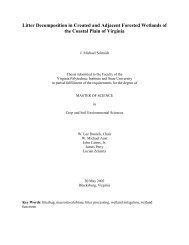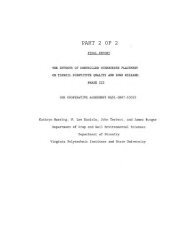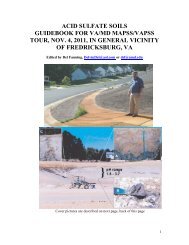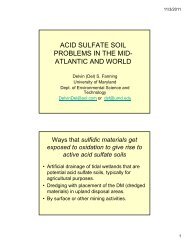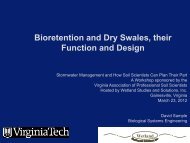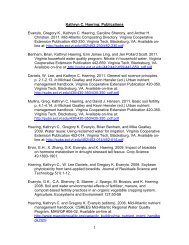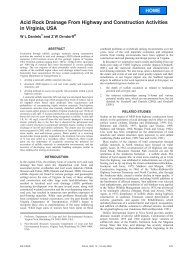Remediation of PAH-Contaminated Soils and Sediments: A ...
Remediation of PAH-Contaminated Soils and Sediments: A ...
Remediation of PAH-Contaminated Soils and Sediments: A ...
Create successful ePaper yourself
Turn your PDF publications into a flip-book with our unique Google optimized e-Paper software.
soil is the primary environmental repository (Dabestani <strong>and</strong> Ivanov, 1999; Juhasz<br />
<strong>and</strong> Naidu, 2000).<br />
Molecular weight, structure, water solubility, <strong>and</strong> vapor pressure <strong>of</strong> each<br />
<strong>PAH</strong> compound affects the potential for <strong>PAH</strong> transfer (i.e. volatilization,<br />
absorption, leaching <strong>and</strong> erosion) degradation (biological <strong>and</strong> chemical), <strong>and</strong><br />
sequestration (adsorption <strong>and</strong> diffusion) (Jones et al., 1996; Pierzynski et al.,<br />
2000; Reid et al., 2000a). Underst<strong>and</strong>ing the fate <strong>of</strong> each <strong>PAH</strong> compound in the<br />
natural environment based on its specific characteristics is important in<br />
determining appropriate remediation techniques.<br />
Molecular weight<br />
Polycyclic aromatic hydrocarbons are classified as low molecular weight (LMW) if<br />
they have two or three fused rings or high molecular weight (HMW) if they have<br />
four or more fused rings. LMW <strong>PAH</strong>s are degraded <strong>and</strong> volatilized more rapidly<br />
than HMW <strong>PAH</strong>s (Harvey, 1997). As molecular weight increases,<br />
hydrophobicity/lipophilicity increases, water solubility decreases, vapor pressure<br />
decreases, <strong>and</strong> the compound will have a more recalcitrant (difficult to degrade)<br />
structure. High molecular weight <strong>PAH</strong>s persist in the environment because <strong>of</strong><br />
low volatility, resistance to leaching, <strong>and</strong> recalcitrant nature (Jones et al., 1996;<br />
Wild <strong>and</strong> Jones, 1995). Molecular weights <strong>of</strong> select <strong>PAH</strong>s are provided in Table<br />
1.<br />
Structure<br />
Polycyclic aromatic hydrocarbons are also classified into two groups based on<br />
ring structure: alternant <strong>and</strong> nonalternant. Alternant <strong>PAH</strong>s such as anthracene,<br />
phenanthrene, <strong>and</strong> chrysene are derived from benzene by fusion <strong>of</strong> additional<br />
six-membered benzoid rings, <strong>and</strong> contain fewer than eight benzoid rings (Harvey,<br />
1998). Nonalternant <strong>PAH</strong>s may contain rings with fewer than six carbon atoms in<br />
addition to six membered rings. This group is extremely broad in structure <strong>and</strong><br />
greatly increases <strong>PAH</strong> diversity (Harvey, 1998). Examples <strong>of</strong> four-, five-, <strong>and</strong> sixmembered<br />
rings are fluorine <strong>and</strong> fluoranthene (Harvey, 1997; Dabestani <strong>and</strong><br />
Ivanov, 1999).<br />
Notice the difference in the two structures <strong>of</strong> alternate <strong>and</strong> nonalternate <strong>PAH</strong>s in<br />
the below diagrams. Chrysene consists <strong>of</strong> four fused, six carbon benzene rings.<br />
Fluoranthene, on the other h<strong>and</strong>, contains naphthalene <strong>and</strong> a benzene unit<br />
connected by a five-membered ring (in the center <strong>of</strong> the structure) <strong>and</strong> is<br />
indicative <strong>of</strong> lower temperature <strong>and</strong> less efficient combustion. Information on<br />
number <strong>of</strong> rings for select <strong>PAH</strong> compounds are provided in Table 1.<br />
Alternate (Chrysene) Nonalternate (Fluoranthene)<br />
5



